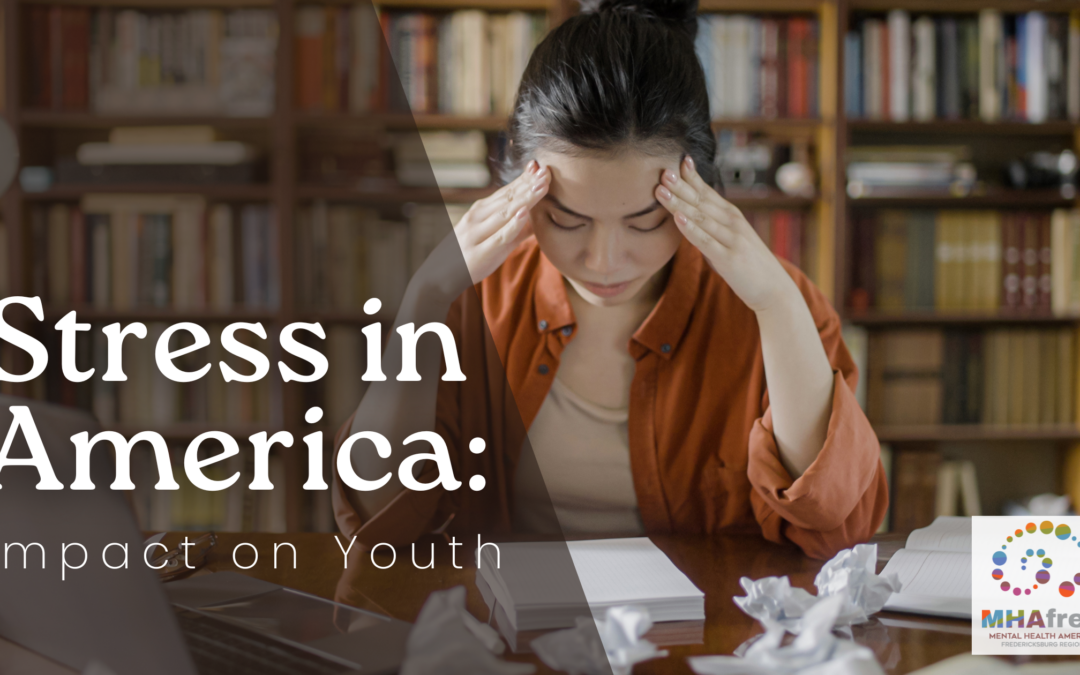“Subject matter experts have recommendations but MHAfred also wants to hear directly from the teens we are trying to help. Sign up to get more information about the upcoming conference – Amplifying Youth Voices – tell us what you need and how we can help.” Barb Barlow, Executive Director of Mental Health America Fredericksburg Region
From the Report, Stress in America
Citation with the link is at the end of this blog.
The American Psychological Association’s (APA) 2024 “Stress in America” report highlights the significant impact of stress on youth, revealing concerning trends and offering actionable steps to mitigate these effects.
The Impact of Stress on Youth
The report indicates that young people are experiencing unprecedented levels of stress driven by various factors, including academic pressures, social media, and global events. According to the survey, a significant percentage of youth report feeling overwhelmed by their responsibilities and the constant connectivity of the digital age.
- Nearly 50% of youth report experiencing anxiety or depression because of their stress.
- Over 40% of young people have trouble sleeping due to stress, which can further exacerbate their mental health issues.
The Most Significant Source – 70% – of Stress is Academic Pressure
The pressure to excel in school, secure college admissions, and meet parental expectations can be overwhelming. This stress often leads to anxiety, sleep disturbances, and even depression.
Social media is linked to stress for 60% of young people
The pervasive influence of social media is another critical stressor. Constant comparison with peers, cyberbullying, and the pressure to maintain a perfect online persona contribute to heightened stress levels among young people. The report notes that many youths feel inadequate and have low self-esteem due to the unrealistic standards set by social media.
Global events cause stress for 55% of youth
The current socio-political climate and international issues such as climate change and economic instability also weigh heavily on young people’s minds. Uncertainty about the future and the perceived lack of control over these large-scale issues add to their stress.
Ways to Address Youth Stress
To combat the rising stress levels among youth, the APA report suggests several actionable steps that parents, educators, and policymakers can take:
1. Promote Open Communication: Encouraging open and honest conversations about stress and mental health can help young people feel supported. Parents and educators should create a safe space for youth to express their concerns without fear of judgment.
2. Implement Stress Management Programs: Schools should integrate stress management and mental health programs into their curricula. Teaching coping mechanisms such as mindfulness, time management, and relaxation techniques has been successful.
3. Limit Social Media Use: Setting boundaries around social media use can help reduce its negative impact. Encouraging youth to take regular breaks from social media and engage in offline activities can promote a healthier balance.
4. Provide Access to Mental Health Resources: It is crucial to ensure that young people have access to mental health resources, including counseling and support groups. Schools and communities should offer these services to help youth navigate their stressors.
5. Foster Resilience: Building resilience in young people can help them cope better with stress. Activities promoting self-esteem, problem-solving skills, and a positive outlook can achieve this.
6. Address Systemic Issues: Policymakers should address the broader systemic issues contributing to youth stress. This action includes advocating for policies that support mental health funding, reduce academic pressures, and address socio-economic disparities.
American Psychological Association. (2024). Stress in America: A Nation in Political Turmoil. Retrieved from APA FEB 23, 2025.Stress in America™ 2024: A Nation in Political Turmoil
Conclusion
The 2024 “Stress in America” report underscores the urgent need to address the growing stress levels among youth and what parents, educators, and lawmakers can do to help. However, supporting young people in building resilience and leading healthier, more balanced lives should also include listening to their voices. Our community’s collective responsibility is to ensure that the next generation is equipped to handle the challenges of the modern world with confidence and strength. We must all work together to succeed, and youth must also be included in forging those solutions.
.

